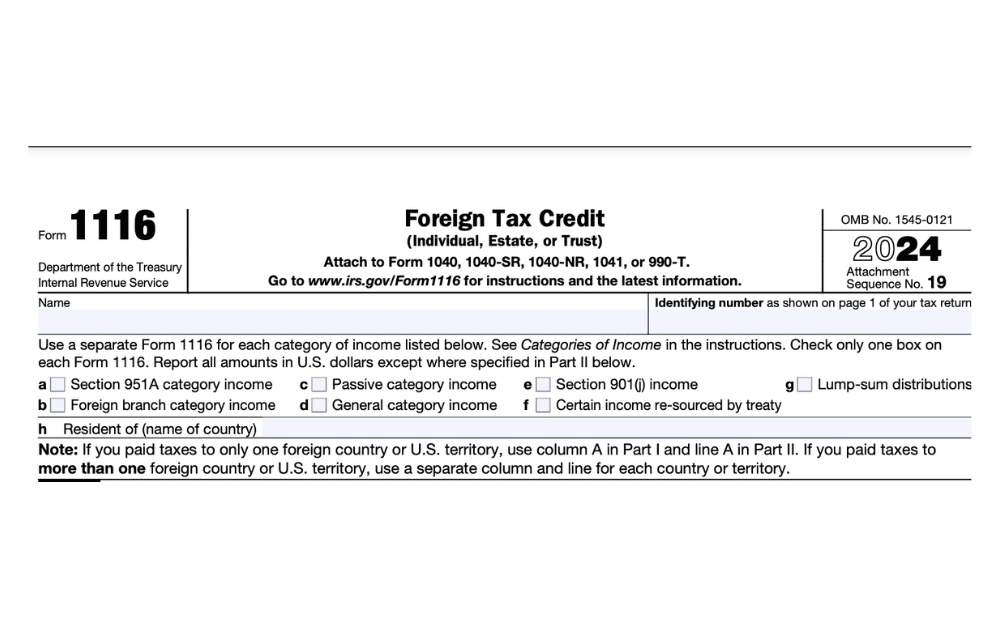Claiming the Foreign Tax Credit with Form 1116

Form 1116 is the tax form used to claim the Foreign Tax Credit. By filing this form correctly, you can save on your taxes and protect your finances overseas. Here’s how!
Key Takeaways
- US expats can use Form 1116 to claim the Foreign Tax Credit.
- This allows expats to receive a dollar-for-dollar tax credit for taxes paid to a foreign country.
- In many cases, the Foreign Tax Credit can erase your US tax obligations entirely.
Avoiding Double Taxation with Form 1116
As an American living abroad, you have several options for avoiding double taxation.
- First, you can deduct your foreign taxes on Form 1040, Schedule A. This functions like any other itemized deduction.
- Another popular option is the Foreign Earned Income Exclusion (FEIE). This lets you exclude a certain portion of your foreign income from US taxation. (For the 2024 tax year, the maximum exclusion amount is $126,500 per person.)
- Finally, you can file Form 1116 to claim the Foreign Tax Credit. This will give you a dollar-for-dollar credit for your foreign income taxes, which you can use to reduce (or even erase) your US tax bill.
For many expats, the Foreign Tax Credit is the best option to optimize international taxes.

Foreign Tax Credit Eligibility Rules
To be eligible for the Foreign Tax Credit, you must meet the four following criteria:
- You must have paid or accrued foreign taxes during the current tax year.
- The tax must be assessed on income.
- The tax must be imposed on you as an individual.
- The tax must be legal and mandatory.
If these are all true, then you are eligible to claim the Foreign Tax Credit by filing Form 1116.
Unlike the Foreign Earned Income Exclusion, you do NOT have to pass the bona fide residence test or the physical presence test to qualify for the Foreign Tax Credit. This makes it a great option for Americans who do not qualify for the FEIE.
Overview of Form 1116
Form 1116 is divided into four parts, each of which will help you calculate and claim the Foreign Tax Credit. Before starting, you will need to know which method of accounting you are using.

Accrual Method: If you use the accrual method, you recognize income when you earn it, not necessarily when you receive it. This method requires you to include foreign taxes in the tax year you accrue them, which might differ from when they are actually paid.
Cash Method: Most individuals use the cash method, where income is reported when received, and taxes are claimed in the year they are paid.
Once you know which method is right for you, you can start on Form 1116.
Part I: Taxable Income or Loss
This section is used to report and calculate taxable income or loss from foreign sources. The income is categorized by the type of income, such as passive income, general category income, and other specific categories like Section 951A category income or income resourced by treaty. Each type has specific rules for how the credit is calculated.

Part II: Foreign Taxes Paid or Accrued
In Part II, you must list the amount of foreign taxes paid or accrued in both the foreign currency and their US dollar equivalent. This section ensures that all taxes claimed are accurately converted and reported, taking into account fluctuations in currency exchange rates. When converting the amounts into US dollars, use the exchange rate on the date the taxes were paid or accrued.

Part III: Computation of Foreign Tax Credit
Part III involves calculating the foreign tax credit for each category of income identified in Part I. Various adjustments are made to determine the amount of foreign tax credit allowed. Most of these are a bit technical in nature. The main purpose of these calculations is to separate foreign income from US-sourced income and taxes paid on foreign income from taxes paid on US income. Once this separation is done, the amount of credit for foreign taxes paid can be determined.

Part IV: Summary of Credits
This part totals all the foreign tax credits from the various categories of income. The final figure represents the total credit that can be applied against the taxpayer’s US tax liability for the year. The credit amount is limited to the lesser of the total foreign taxes paid or the US tax liability attributable to foreign source income.

To learn more, see the instructions for Form 1116 provided on the IRS website.

Reporting Foreign Income with Form 1116
Form 1116 has seven types of income you can report. When filling out your form, you’ll need to know which types apply in your case.
1. Section 951A Category Income
This category includes income from controlled foreign corporations (CFCs) that are subject to US shareholders under global intangible low-taxed income (GILTI) provisions. GILTI does not include passive category income but instead means intangible income from foreign sources that US shareholders must report and pay taxes on.
2. Foreign Branch Category Income
This includes income from foreign branches of US persons. Profits earned by these branches are reported here, excluding passive income. The income must be tied to a qualified business unit (QBU) operating in a foreign country.
3. Passive Category Income
Passive income typically includes earnings from investments such as interest on foreign bank accounts, dividends from foreign corporations, royalties from foreign licenses, and annuities. This category is important for taxpayers with investment income abroad.
4. General Category Income
General category income includes wages and salaries earned abroad. It also includes any passive income that was removed from the passive category and moved to the general category due to the High Tax Kick Out (HTKO) rules. The change is required when passive income is subject to high foreign taxes. Income is considered “highly taxed” if the foreign tax rate exceeds the US tax rate. The general category also includes income that doesn’t fit into the other specified categories.
5. Section 901(j) Countries
This category includes income from countries designated by the US government as supporting terrorism or lacking diplomatic relations with the US. Income from these countries must be reported separately due to specific restrictions and rules governing such income. This includes countries such as Iran, North Korea, and Cuba.
6. Resourced by Treaty
Certain income may be resourced by treaty if a tax treaty between the US and the foreign country specifies how the income should be treated. This category includes income that, under treaty agreements, is considered sourced to the foreign country for tax purposes, even if earned in the US. This can help avoid double taxation under mutual agreements.
7. Lump-Sum Distributions
This includes income from lump-sum distributions, such as payouts from foreign pension plans.
If your Foreign Tax Credit exceeds your US tax bill, you can carry the balance forward or back to other years!
Claiming the Foreign Tax Credit without Form 1116
In some situations, US taxpayers can claim the Foreign Tax Credit (FTC) without filing Form 1116. Here are some common examples.
1099-Reported Passive Income
If all your foreign-taxed income comes from passive sources, such as interest and dividends, and is reported on Form 1099, you might not need to file Form 1116. This applies to Single filers who paid $300 or less in foreign taxes and married joint filers who paid $600 or less. Instead, you can enter the amount of foreign tax credit directly on Schedule 3. Although you may qualify not to file form 1116, there are a few reasons why you may want to file it anyway.
US Territories
If your income is sourced from a US territory such as American Samoa, Puerto Rico, Guam, or the US Virgin Islands, specific rules apply. Although income from these territories is considered foreign for the FTC, the IRS provides simplified procedures for taxpayers earning income in these areas, often negating the need for Form 1116.
Let Greenback Take Care of Your Form 1116!
Greenback Expat Tax Services is an American company founded by and for expats. We help Americans around the world file their international taxes accurately and on time — all while maximizing your savings!
Contact us, and one of our customer champions will be happy to help. If you need very specific advice on your specific tax situation, you can also click below to get a consultation with one of our expat tax experts.



